UNDERGROUND ARMY IN BID FOR POLAND’S FREEDOM
Warsaw, Occupied Poland · August 1, 1944
When British soldiers landed on Normandy’s Gold, Juno, and Sword beaches on June 6, 1944, they came upon Germany’s Leichter Ladungstraeger (“light charge carrier”) named Goliath, a tank-tread robot approximately 4 feet long, 2 feet wide, and 1 foot tall that carried 170–220 lb of high explosives. Known as the beetle tank to the Allies, the robot tank was steered by a joystick control box via a 700‑yard cable connected to the rear of the vehicle. Prior to Normandy, Goliaths saw action at Anzio in Italy in April 1944 and most notoriously in the two-month-long Polish Warsaw Uprising, which began on this date in 1944, as Wehrmacht and units of the ruthless SS (Schutzstaffel, or protection squad) rushed to crush fierce Polish resistance by the underground Polish Home Army (Armia Krajowa). Polish insurgent volunteers, armed only with light weapons and cutters, were credited with successfully severing the command cables of some of the Goliaths before they reached their intended targets. The insurgents’ intention was to expel the Germans from the Polish capital and pave the way for the legitimate Polish government to return to Poland from exile in London. The underequipped Polish Home Army, numbering between 20,000 and 49,000 men, women, teenagers, and children in the beginning, surrendered on October 2, 1944, but not before killing and wounding 16,000 Germans and their allies; another 7,000 Germans were listed as missing in action. Although the exact number of Polish casualties remains unknown, it is estimated that about 16,000 members of the Polish resistance were killed and some 6,000 badly wounded. Until mid-September, the Germans shot all captured insurgents on the spot, but from the end of September, some of the captured Polish soldiers were treated as POWs (roughly 15,000). In addition to insurgent deaths, between 150,000 and 200,000 Polish civilians died, mostly from mass executions carried out by special units of the SS, police, and Wehrmacht that went from house to house, shooting the inhabitants regardless of age or sex and burning their bodies. Forced to abandon Warsaw in January 1945, the Germans left the Polish capital a “ghost city,” over 85 percent destroyed.
[amazon_carousel widget_type=”ASINList” width=”600″ height=”200″ title=”Recommended Reading” market_place=”US” shuffle_products=”False” show_border=”False” asin=”0143035401,1848842813,0374286558,0811713156,1589019830,0781810353,0781813026,0299207307,0275970051,1846033527″ /]
Warsaw Uprising, August 1 to October 2, 1944
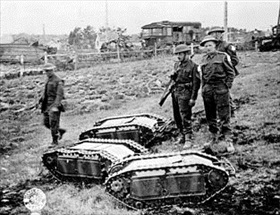 | 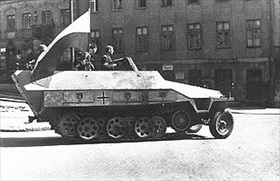 |
Left: British soldiers with captured German Goliath tracked mines during the Normandy Invasion, 1944. Although over 7,000 Goliaths were produced, the single-use tracked mine was not considered a wartime success story due in part to its high unit cost and low ground clearance. Goliaths were among the 310 tanks and armored cars the Germans lost in the two-month-long Warsaw Uprising.
![]()
Right: A German armored fighting vehicle captured from an SS division by Polish insurgents on August 14, 1944. The Polish underground exploited the Wehrmacht’s distraction caused by Operation Bagration, the Soviet advance into eastern Poland, to launch Poland’s bid for freedom.
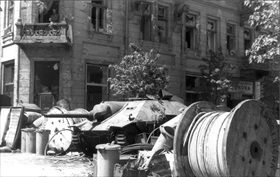
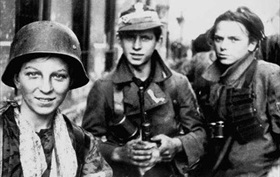
Left: Polish barricade on the Napoleon Square build around a German tank destroyer captured by the Polish Home Army. The Home Army was the most significant resistance movement in occupied Europe.
![]()
Right: Teenage Polish Boy Scout soldiers shortly after emerging from a Warsaw sewer early in the morning of September 2, 1944.
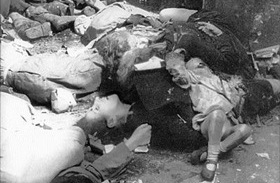
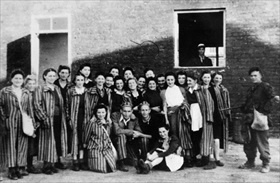
Left: Polish civilians murdered by the infamous SS penal brigade commanded by Oskar Dirlewanger, who reported directly to Reichsfuehrer-SS Heinrich Himmler, August 1944. In the westernmost Warsaw boroughs of Wola and Ochota, estimates of civilians killed range from 20,000 to 50,000 (40,000 in Wola alone by August 8, 1944) or as high as 100,000. Dirlewanger, a psychopathic killer and convicted child molester, died in Allied custody, apparently beaten to death by his guards.
![]()
Right: Despite the loss of Wola, Polish soldiers managed to capture the ruins of the Warsaw Ghetto and liberate the Gęsiówka concentration camp on Gęsia Street on August 5, 1944, freeing about 350 Jews. This photo show Jewish women posing with their liberators.
![]()
Below: Monument to the gallant but doomed heroes of the Warsaw Uprising, Krasiński Square in Warsaw’s Old Town.
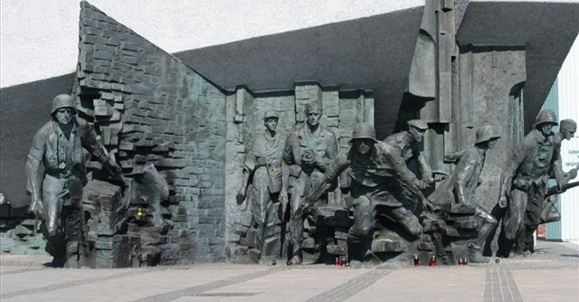 |
CNN Documentary About the Warsaw Rising, August–October 1944
![]()

 History buffs, there is good news! The Daily Chronicles of World War II is now available as an ebook for $4.99 on Amazon.com. Containing a year’s worth of dated entries from this website, the ebook brings the story of this tumultuous era to life in a compelling, authoritative, and succinct manner. Featuring inventive navigation aids, the ebook enables readers to instantly move forward or backward by month and date to different dated entries. Simple and elegant! Click
History buffs, there is good news! The Daily Chronicles of World War II is now available as an ebook for $4.99 on Amazon.com. Containing a year’s worth of dated entries from this website, the ebook brings the story of this tumultuous era to life in a compelling, authoritative, and succinct manner. Featuring inventive navigation aids, the ebook enables readers to instantly move forward or backward by month and date to different dated entries. Simple and elegant! Click 











